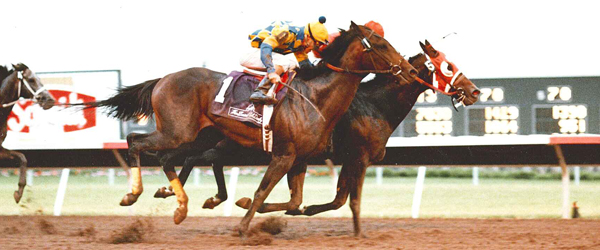 The sportscasts percolated with the details that evening and banner headlines blared the news the next morning.
The sportscasts percolated with the details that evening and banner headlines blared the news the next morning.
A longshot – 72-1 mind you – had won the inaugural running of the $300,000 St. Paul Derby, a race that became at first asking the crown jewel of Minnesota horse racing.
The year was 1986 and the horse was Cheapskate (pictured above on the inside) who turned out to be anything but – nothing cheap whatsoever about a $2 ticket that returns $146 at the window, and 23,351 fans witnessed the pulsating finish in this headline grabbing race.
Horses that had run earlier in America’s Classic Races were vanned or flown into Shakopee to participate, Kentucky Derby participants Broad Brush, Bachelor Beau and Rampage that first spring. It was Broad Brush, the third place horse at Churchill Downs the previous month, who engaged Cheapskate in a scintillating stretch duel before losing by a nose to the New York-bred upstart.
Thus began a short five-year span that produced some of the most memorable names in the early history of state pari-mutuel racing – Cheapskate, Lost Code, Fourstardave, Clever Trevor and Secret Hello.
The St. Paul Derby immediately became the trademark race of Canterbury Downs, was awarded Grade III status for its second running, then became a Grade II race and annually drew one of the largest turnouts and betting handles of a season. A crowd of 23,000-plus that first year wagered $2,146,546 million on the card. A turnout of 23,171 pushed $2,265,204 through the windows in 1987, and 15,744 wagered $1,808,401 the next year.
Now, 26 years after Cheapskate became the buzz at water coolers across the state on a Minnesota Monday morning, the Derby returns, this time as the $150,000 Mystic Lake Derby. The St. Paul Chamber of Commerce and much of the city’s business community rallied with sponsorships and promotion of the race named for the Capitol City back then. Now, it is the Shakopee Mdewakanton Sioux Community that has joined forces with Canterbury Park to create the biggest purse since the St. Paul Derby became the $250,000 Minnesota Derby in 1991.
“This now has become our signature race and we hope the first step in bringing back the type of race seen in the early days of Canterbury,” said track president/CEO Randy Sampson. “We’d like to get back to that type of racing with the Mystic Lake Derby. That is totally the idea.”
Although many of those early racing crowds were large and wagering robust, most Minnesotans didn’t recognize what they had in those formative years – top-level racing from top-level horses and stables. The promotional agreement and enhanced purse fund from the recent pact with Mystic Lake point once again in that direction, at a minimum to stabilized, improved racing for the state’s thoroughbred and quarter horse industries.
The Mystic Lake Derby is a symbolic nod to the past but an also a glimpse into the future of Minnesota racing.
“Yes, this is a stepping stone so to speak,” said HBPA president Tom Metzen. “Next year it will be an even bigger race, and Mystic Lake deserves it. There are so many things that are right about this agreement, and the Mystic Lake people have been absolutely gracious to deal with.”
Perhaps the future includes some of the wonder, glory and romance of those early St. Paul Derby days. Consider, for example, the following:
Broad Brush, the runner up to Cheapskate by maybe three inches, Bachelor Beau and Rampage were all Grade I winners. ESPN broadcast that first Derby to 1.1 million viewers, making it the highest rated presentation on its Budweiser Racing Across America Racing series that year.
Lost Code, the son of 1980 Preakness Stakes winner Codex, found the right strategy for winning the 1987 St. Paul Derby, a gate-to-wire romp against seven rivals, including Florida Derby winner Cryptoclearance who finished fourth in the Kentucky Derby, third in the Preakness and second in the Belmont Stakes that spring.
Fourstardave became the second New York-bred horse to win Minnesota’s biggest race, in 1988, but arrived without a rider. No was willing to ride the horse for trainer Leo O’Brien until he got to Shakopee and spotted an old friend, Daryl Montoya, on the list of jockey names.
The result was magical. The horse no one wanted to ride went off at 21-1 and provided Montoya with the biggest win of his career.
The 1989 St. Paul Derby, Clever Trevor’s Derby, was the first race simulcast from Canterbury Downs and drew wagering of $469,613 from other tracks in addition to the on-track $319,854 bet on the race. Ak-Sar-Ben, Remington Park , Detroit Race Course, Thistledown, Blue Ribbons Downs and Ruidoso Downs offered the Derby and introduced Canterbury to a new aspect of wagering.
Then came the final St. Paul Derby, in 1990, and a horse named Secret Hello, ridden by Pat Day and trained by Frank Brothers. Secret Hello claimed the winner’s share of $300,000 and his share of the $100,000 bonus as a Grade I winner, the first horse to do so. Instead of $180,000, Secret Hello collected $240,000 that day.
A sidenote: Fourth that afternoon was the Brothers-trained Appealing Breeze, who the previous summer on the same track had won the Canterbury Juvenile over Unbridled, the 1990 Kentucky Derby and Breeders’ Cup Classic winner and that year’s Eclipse Award winning three-year-old colt.
There it is, a taste of Canterbury ‘s St. Paul Derby past and perhaps a look into its future, beginning with today’s Mystic Lake Derby.
This blog was written by Canterbury Staff Writer Jim Wells. Wells was a longtime sportswriter at the Pioneer Press and is a member of the Canterbury Park Hall of Fame.